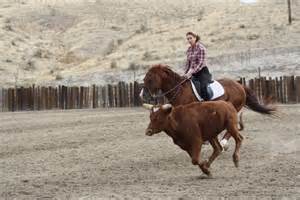Bettina’s memorial service is scheduled for 6 May 2025 at 11 a.m. (Eastern Standard Time). A Zoom link has been created for those who cannot attend in person. To access the Zoom link Click Here.
To access the program for the service and the link to view the Memorial Slide Show of Bettina’s life with horses click here.
Bettina’s students and friends have also shared their memories of Bettina. Read the stories of their memories by clicking here.
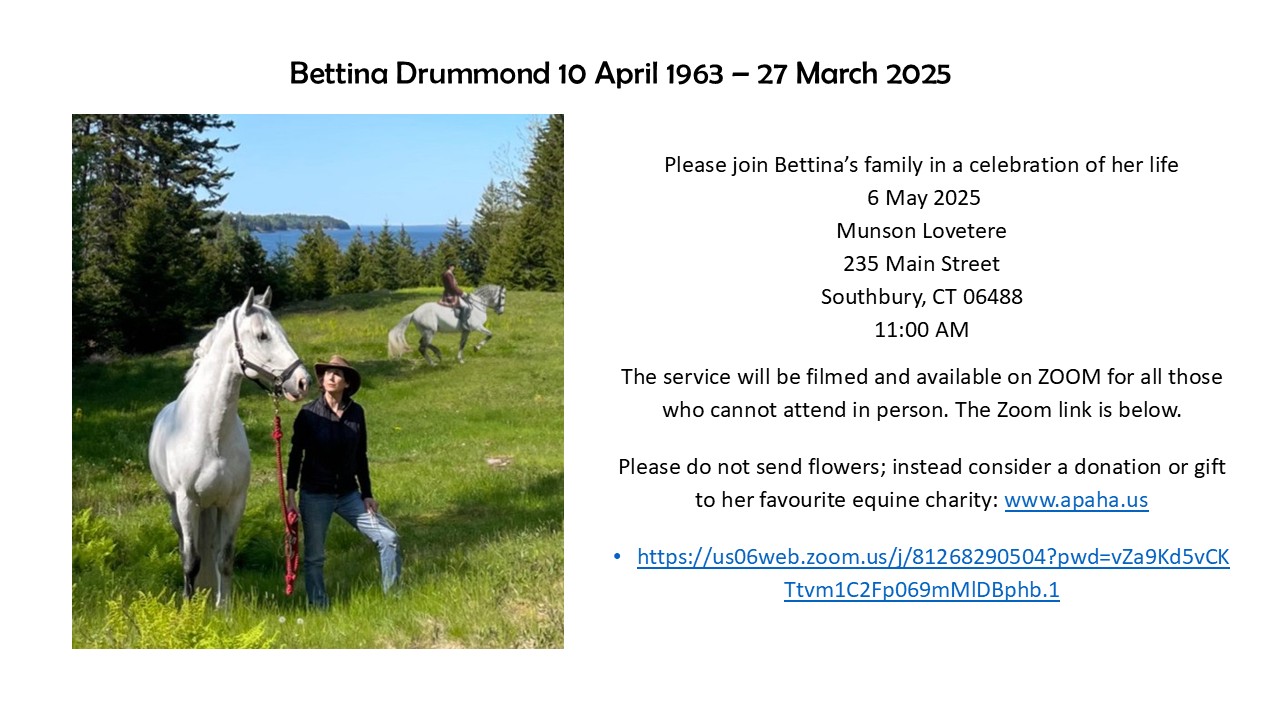
BETTINA DRUMMOND: 1963-2025
A True Artist of Riding
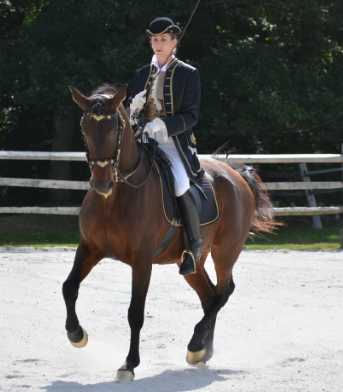
It is with great sadness that we announce the loss of our great friend and teacher Bettina Drummond. Bettina, 61, lost her more than four-year battle with metastatic breast cancer on March 27. Throughout her cancer battle, she continued her efforts to educate riders and trainers – through exhibitions, clinics, virtual lessons and interviews – in order to preserve riding as an art form. Bettina was known by many as a great rider and trainer but she saw herself as an artist and horses as her friends and partners in creating that art.
Bettina was highly regarded in both the United States and Europe as a rider, trainer and teacher in the French Classical System. In 2018, she was named an “Honorary Écuyer” of Saumur with the Cadre Noir at the French National School of Equitation in Saumur, France. She was only the second American to receive this honor and at the time, only the second woman to be named Honorary Écuyer. The other is French Olympic dressage rider Margit Otto-Crépin.
As an artist, Bettina moved and inspired not only those who saw her riding exhibitions but also many other artists. In 2012, she was honored by the prestigious Brooklyn, New York-based STREB with their annual Action Maverick Award. At STREB’s annual fundraising and awards banquet, Bettina decided to give STREB’s benefactors a first-hand view of her art. She arrived with the Lusitano stallion Que Macho and amidst a formally-dressed crowd seated at the dinner tables, Bettina and Macho moved around and between the tables performing to the music of Grace Jones’ “Hurricane.” It was a stunning performance of the partnership of two beings – human and horse – that left dinner guests speechless.
The beauty of Bettina’s riding inspired artists of multiple disciplines. She was a muse for painters, sculptors, musicians, composers, dancers and more. She was a strong believer in the artistic power of collaboration and rode to musical compositions inspired by her riding, around art work of many types from paintings to sculptures also inspired by her riding, danced on horseback with human dancers on the ground and glided around rings to the music of live musicians from all genres of music. She astounded students with her encyclopedic knowledge of music, pointing out at one moment how a horse’s movement would fit beautifully with a small movement within a huge classical piece of music and then later begin a discussion on what she found interesting in a country or rock song. It seemed that where art was concerned, there was nothing of which Bettina was not aware and had not thought of how that art could inspire her own.
Bettina’s own artistic endeavors went beyond riding and included her love of playing piano and the writing of poetry. She had a special place in her heart for those artists with the courage to explore beyond normal boundaries, one of whom was Tom Petty. After his passing in 2017, Bettina wrote “… a fellow poet, artist and rebel who was a great inspiration to me in my own craft. His music, particularly in the 1990s, was the inspiration that re-inspired my art after Oliveira passed away. Among his music that most touched me were “I Won’t Back Down” and “Free Falling.” Petty was a true source of inspiration, both in the beauty of his words and in his intransigent libertarian thoughts. I was 11-years-old when I heard his voice and words and witnessed his style on the British Top of the Pops show. It was years later, as I was perceiving my own art form as an independent expression, that I heard his own art form and voice. I realized then that art is about the strength of conviction and uproar that one conveys. This through body language, verbal assertion and mindfulness. He was a great artist and an apologetic iconoclast. I was lucky to live during his time.”
Bettina was also a well-known Star Trek fan. For many years, it was easy to spot her on the road with her white pick-up truck and its beautiful painting of the Starship Enterprise on the tailgate. As the years went by, Bettina became an ever-bigger fan of William Shatner as another example of an artist, and fellow rider, who refused to let age and life define him. One of her great moments in life came in spring 2022 when she traveled to the Midwest to teach some of her students and they gifted her with tickets to a Michigan event where Bettina was able to meet William Shatner in person.

Bettina was born in London and was part of the Marshall Field family on her mother’s side and of ancient Scottish royal blood on the side of her father, Bend’or Drummond. She was raised mostly in Europe, particularly Paris, but also in America. She recalled that her education as a rider began at the tender age of three on a family estate in South Carolina.
“My first memory of riding was being in a Western saddle that was way too big for me. My feet stuck out on each side of the pommel,” Bettina once said. That pony ride was the first step in her life-long equestrian education. Riding, however, was not her first love as a child. “I’m a thwarted musician. I always wanted to be a pianist.” Her love for the piano and music continued throughout her life and she once credited her mentor and teacher Nuno Oliveira, whose passion for opera was well-known, for helping her understand that riding could become a way through which she could express her own artistic nature.
It was as a student of Oliveira, known as perhaps the greatest riding master of the 20th century, that Bettina first became well-known. She spent 17 years in training with Oliveira, beginning at age seven. She earned the coveted spurs awarded to instructors at the age of 17 and was recognized as a master trainer at 21. She was also influenced and coached by some of Europe’s other great riders and trainers, including General Durand, Ecuyer en Chef and Commandant of the French National Equestrian School in Saumur, hence her long association with Saumur, and with Lieutenant Colonel Paolo Angioni of the Italian Cavalry. While many associate Bettina with the classical riding of European tradition, in reality, Bettina’s quest for knowledge led her to cross into many equestrian disciplines to explore other methods and theories and to engage in deep discussions with others who were seeking balance and lightness in their riding.
As a young rider with Oliveira, Bettina had the experience of sitting around a table while he and other great riders of the age debated theories and methods of riding and training. Bettina came to see that riding and training was an academic pursuit, much like that of other academic disciplines, such as philosophy, of which she studied in college and remained a life-long student. Hence, Bettina was open to discussion with riders and trainers of any equestrian discipline who shared her quest for equestrian knowledge. Her well-known Quarter Horse stallion Vousy was her own experiment into understanding not only how one could apply classical principles to that type of breed but also an exploration into the theories and methods of cowboy trainers with whom she often had dialogues, such as Tom Curtain and Martin Black.
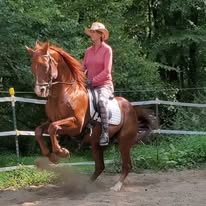
For Bettina, the training of horses was a process by which she carefully developed her equine artistic partners so that together, they could create art. She was not concerned with riding as competition but rather as something in which horse and rider could merge into perfect balance and harmony to produce something that moved and inspired.
“Art is the overlap of words, sounds and feelings. The key of art is not getting lost in it,” she once said. “For centuries, artists have recognized the horse as a work of art in itself. As a rider, my goal is to allow the horse to express its own artistic nature.” Bettina said it was a vision of Oliveira on horseback that made her aware of riding as art and she remembered the very day that awareness came to her. She was 10 years old and sitting as she read A Collection of Lectures on Literature by Nabokov. As she was reading a passage where the words evoked the idea of lightness and form, she glanced up and caught sight of Oliveira on horseback silhouetted by the sun. It was at a moment when he and the horse were in perfect balance.
“What struck me was how immobile was his body and how in balance he was with the horse. The vision fit the force of the words,” Bettina said.
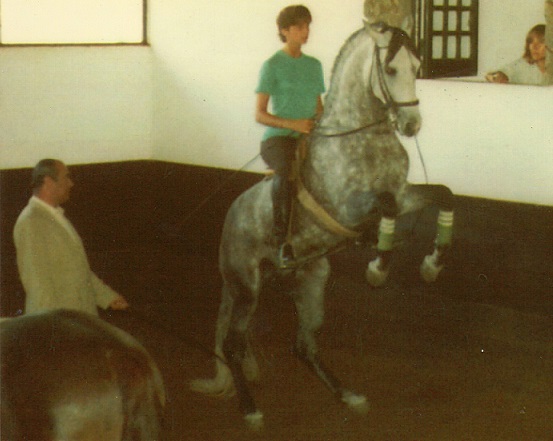
Her artistic creations went beyond her riding to include poetry. Her own poems have circulated through Europe and been well-received among a closed circle of distinguished European poets. Among poets, she credited Baudelaire and the Russian Anna Akhmatova as great influences.
To Oliveira, she gave credit for giving her the unique opportunity to ride horses he trained so that she could feel true balance and lightness on horseback. But it was also he that Bettina said helped her understand that the opportunities to express art through riding were endless because each horse is an individual. The belief that there can be no one training method applied to every horse, learned from Oliveira, was central to her training approach and a key reason why she never promoted a set “method” of training. How one approached the training of a horse depended on the individuality of each horse. Much of her great success in training came from an ability to understand each horse as an individual. This is why training must be tailored specifically for each horse and why, she often said, “it takes the time it takes,” meaning that how long it took to teach something to a horse varied by horse. For Bettina, the wonderful thing about this individuality in horses was that every horse provided her with a new opportunity to hone her craft and present her art in a new way.
“As a rider, what I wish to pursue with each of my horses is to find that point of balance. And my development as a trainer and rider has allowed me to find that point much quicker with each succeeding horse. I am grateful that Oliveira taught me early on in life how to feel this moment,” she said.
The movement she saw Oliveira ride silhouetted against the sunlight was a transition from walk to piaffe. When she reached that point in her own riding where she experienced that movement in perfect balance for herself, Bettina came to understand that as a rider, one can tap into how horses speak to us through their bodies. “The horses themselves are the art and we simply insert ourselves into that.” It was a process through which she often passed in her life as a rider – first seeing it and then experiencing it.
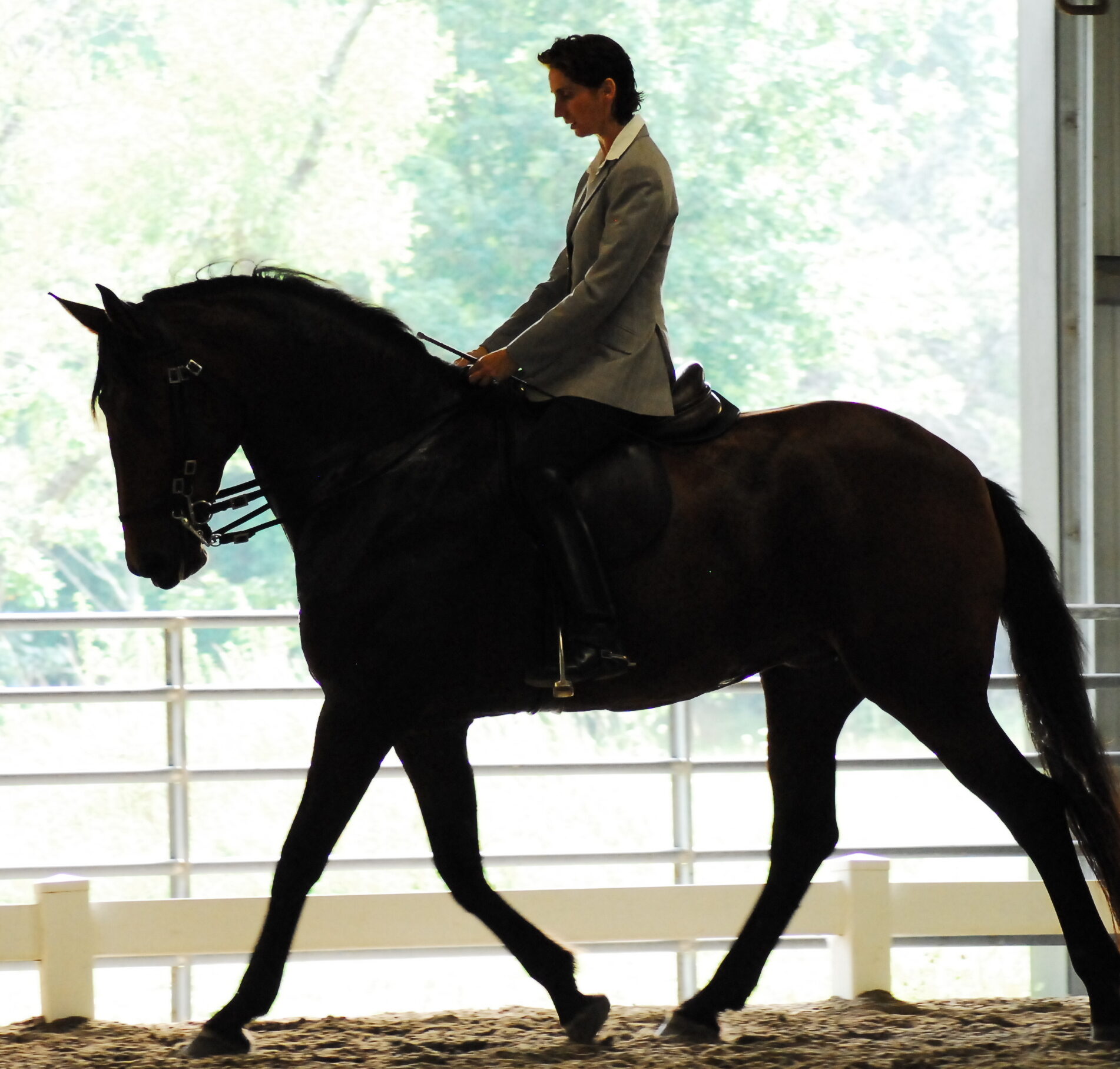
The term “Renaissance woman” truly applied to Bettina. She studied philosophy at the University of Chicago where she went particularly to study with Alan Bloom, a noted philosopher. She spoke five languages – French, English, Portuguese, Spanish, Russian and Latin. She could hold her own in conversations with noted experts on topics ranging from wine to great authors to world politics.
“As a rider, I believe you must be a thinker. You get off, go home and think. That’s the study of philosophy – cause and effect,” Bettina once said. She recalled with humor having once been told that Oliveira was heard to say to a friend, “You know, Bettina, she’s even intelligent.”
In the later years of her career, Bettina not only explored beyond more boundaries of her art but also worked to disseminate the knowledge she had gained as a rider and trainer to her many students. The transmission of knowledge became more and more important in her life because she believed that “it’s important that the craft of classical riding grow and not die. And it would seem a shame to me if I did not pass on what I’ve learned.” It was this desire to share knowledge that led Bettina to invest time and energy into the creation of the Association for the Protection of the Art of Horsemanship in America (APAHA). She once admitted, however, that learning to be a teacher was a very long process for her. Because she was an instinctive rider, she lacked the patience required of a good teacher. It was only through years of working with good teachers that she learned how to teach and gained the patience needed to explain things to students. Bettina took the role of teacher very seriously and was quick to distinguish between a “riding instructor” and a “teacher.”
“We need ways to reward the craft of teaching, not just reward who wins in shows. When I made mistakes in my training, I had intellectuals in the art of training with whom I could converse and seek advice to correct my mistakes. People who are steeped in theory seem to be in shorter supply today.”
Gen. Durand, one of Bettina’s mentors, was once asked his view on the question of whether dressage is art or sport. His answer was simply that “a true artist cannot imagine competition. It should be art first, then competition.” He then noted that one cannot ride by number to be a great, artistic rider any more than one can paint by number and become a great painter.
Bettina never rode by the numbers, and she courageously colored outside the lines. And in doing so, she created amazing art. She rode to create her own version of art with the hope that in the end, it would inspire others to follow their own artistic paths. The greatest gift that her students and followers can give back to her is to show the courage to pursue their own artistic paths and to remember that horses are partners in that pursuit, not tools.
A Poem by Bettina Drummond
Early morning frost
Shadows weave across the light, a strange mosaic gift that stains my floor:
it takes my feet straying on to empty places. I walk within this narrow corridor
to find the years have fled my steps to whisper hints of truth within my heart.
They lie in dormant places creeping into form at times, in a breath or set apart.
The cold has found its voice, claims that all life now exists bleached to white…
All fails but naught cries out, the thwarted ice strikes sparks into a winter’s night.
(In the coming days and weeks, APAHA and Bettina’s students will be working to make available more and more of the photos and videos from Bettina’s career as a rider and artist in hopes of following through with her quest to share knowledge and inspire. This work will be added here on her website, where one can already view many videos and photos of her career.)
